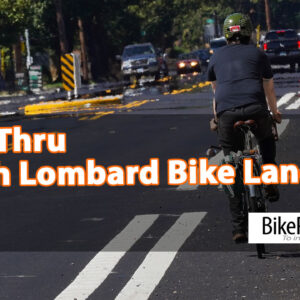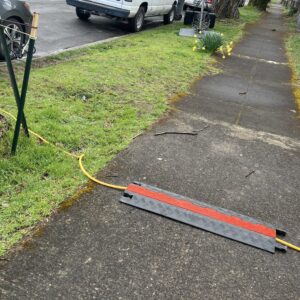
A recent Oregon Department of Transportation project in north Portland has helped tame an urban highway, but it came at the cost of a key bike crossing. It’s a trade-off we shouldn’t have to make.
I’m talking about the project that brought new pavement and a new cross-section to NE Lombard (U.S. 30) between St. Johns and the Kenton neighborhood. The new buffered bike lanes and other changes have made the once-unthinkable-for-cycling street into a viable route. I’ve ridden it several times in recent weeks and drivers go much slower and it actually feels OK in the bike lane.
But what ODOT did at the North Delaware Avenue intersection is not OK.
The project removed a traffic signal that could be instantly activated via push-button on either side of Delaware. For southbound Delaware bicycle riders, the button was right near the curb and could be pushed without having to roll onto the sidewalk. Now there’s a rapid flashing beacon on just one side of the intersection, which means if southbound bicycle riders want the protection of the crossing, they have to cross over a lane of traffic twice.
“It is also really annoying and potentially unsafe,” one mom who bikes her kids to school and parks on Delaware told us after the changes went in. “It’s a huge pain for cyclists… Definite downgrade from what was there before,” said another. Both people wanted to know why ODOT did it.
The first thing I did was confirm the design with one of the ODOT engineers who worked on the project. “Yes, this is the final design,” they said. “Southbound or northbound bike riders would need to either treat the Delaware approach like a vehicle or a pedestrian.”
It wasn’t until a few weeks later that I learned more about why they made this decision. It seemed like an interesting example of how arcane federal engineering guidelines can have an impact on our everyday experience on our bikes.
Here’s what I learned:
- The old signals were “half signals.” This is where the signals only stop half of the intersection — in this case the signals stop the major street in favor of the smaller side street without a signal. The Federal Highway Administration’s all-powerful Manual on Uniform Traffic Control Devices (MUTCD), a guidebook (more like a bible) used by state traffic engineers, strongly encourages their removal, “because of the issues such designs cause when the interruption of the major-street traffic flow by a pedestrian actuation is used by side-street drivers as their opportunity to turn onto the major street, in conflict with the crossing pedestrians,” reads the FHWA website.
- ODOT didn’t opt for a new traffic signal at this location for several reasons. First, it would have added cost to the project that wasn’t in the budget. But even more importantly, the MUTCD requires a specific amount of cross-traffic before a signal can be installed (this is known as “meeting signal warrants”). An ODOT spokesperson told me the traffic volumes on Delaware would have to be 3-4 times higher during peak hours to event come close to meeting signal warrants.
- A HAWK (“high intensity activated walk”) signal couldn’t be used here because those are typically only used at mid-block crossing locations. * UPDATE, 11/3 at 8:47 am: To further clarify, ODOT prefers to not use HAWK signals at intersections, but that’s not the case with PBOT. The two agencies differ on this issue.
So that’s why the crossing of Delaware and Lombard is worse for bicycle users today than it was before ODOT’s project. It’s a clear example of how arcane federal engineering guidelines can impact your bike route to school.
The good news is that the City of Portland manages Delaware and they have a much less rigid interpretation of the MUTCD. And since it’s such an important and popular route to schools and parks and other destinations, I won’t be surprised if PBOT manages to add some bike-friendly crossing features back to this intersection as part of an upcoming neighborhood greenway project. Stay tuned!







Thanks for reading.
BikePortland has served this community with independent community journalism since 2005. We rely on subscriptions from readers like you to survive. Your financial support is vital in keeping this valuable resource alive and well.
Please subscribe today to strengthen and expand our work.
I would not cross my fingers and hope for PBOT to fix this: they closed a crosswalk across Naito from downtown. THey also closed a crosswalk at SE 12th/Madison a cople of years ago. And probably 10 more across the City including in East Portlnad ads part of “safety projects” (nothing improves safety like reducing crossing options and favoring people driving). If PBOT can’t or won’t open corsswalks in very central, highly pedestrianized parts of town, why would care about anything in North Portland?
The Delaware crossing has become supper sketchy now that the signal was removed. Hopefully they can get it back in. Also sad to see that the Lombard crossing at Villard/Peninsular bike route is now blocked with the new street configuration. What is even more confusing is they put up a crosswalk closed sign directly next to the only legal crosswalk at that intersection. Seems like it is assumed that everyone just travels east west direction and we and no one travels south north routes.
I think PBOT actually opened the dorr for ODOT to walk through- they have been lazily closing crosswalks all over town for the past 3-4 years. It is shocking and inexcusable for PBOT and ODOT to do this.
The argument against the half signal is so frustrating: …”because of the issues such designs cause when the interruption of the major-street traffic flow by a pedestrian actuation is used by side-street drivers as their opportunity to turn onto the major street, in conflict with the crossing pedestrians,” Which is exactly how all drivers on side streets also treat rapid flashing beacons. The only difference is that a signal is widely undestood and followed: after 1 or 2 cars drive through the red light, the rest of the traffic stops. Fewer drivers know what do at a flashing light.
Is that from ODOT or the MUTCD? I prefer half-signals for sure, but that excuse feels thin. There’s a HAWK at 26th and Broadway, for example. It can be done!
Exactly, I hope they don’t take out that one on broadway too, there would be no safe way to cross Broadway on the so called 28 street greenway if they do
PBOT does lots of HAWK signals at intersections. ODOT are the ones who refuse to do them. The MUTCD is just a guidebook and open to interpretation by agencies.
Correct. ODOT likes the legal defensibility of following the MUTCD, though, and is extremely (fully?) reticent to veer off from its guidelines.
I’m also not a fan of mid-block HAWK lights. The objective is for them to get used, and if I have to pedal half a block on a sidewalk to reach one, I’m less likely to use it, and instead try to cross with no protection at the intersection.
ODOT has a intersection crosswalk at Powell and SE75th, but in order to comply with the “no HAWK at intersections” rule, that crossing has no HAWK light. Is that better?
Every HAWK signal in the city that I know of are at intersections…
Many have commented on how PBOT will install HAWK signals at intersections while ODOT will not. PBOT has chosen to accept the tort liability risk by choosing to ignore the MUTCD while ODOT is not willing to accept that risk. The MUTCD specifically calls out HAWK signals (called Pedestrian Hybrid Beacons in the MUTCD) to be located at least 100 feet away from side streets controlled by stop or yield signs. All public streets are required to follow the MUTCD by statute in Oregon & similarly by statute in the 49 other states. If PBOT or ODOT lose in court it’s you & I footing the legal costs & payout.
I haven’t ridden it but I was wondering how effective it was. NextDoor is treating it like the apocalypse and having meltdown posts about it so that made me think it was doing a good job.
its actually really pretty nice, Lombard has a more human scale feel to it now. Not so much a freeway that you never want to walk (or ride) down. I’ve been also seeing more pedestrians out and about and people visiting businesses
The MUTCD is basically a handbook on how to exclude non-automobiles from intersections. In the 2021 Design for the Rose Quarter Project (https://www.i5rosequarter.org/pdfs/2021_design_update/I5RQ_20p_Design_Compiled_Narrative_Appendix%20S_remediated.pdf), ODOT is planning on closing the east leg of the Weidler/Vancouver crosswalk because “Crosswalk would conflict with SB dual left turn or NB dual right turn phases creating a safety concern for crossing pedestrians”.
The solution is always get rid of pedestrians/cyclists so that traffic can move “smoothly”. That stated reasoning from the FHWA is really rich too, I mean can’t let a pedestrian stop traffic on a busy road, a car might hit them while turning! Just absurd stuff written by people who have evidently never tried to cross a busy road on foot.
I loved having that signal as a car driver..perfect to park/ pop out n push button for red light – knowing whichever way I wanted to go would be SAFE. No ifs ands or buts…SAFE for everyone involved at that intersection, in all 4 directions.
I’ve heard PBOT engineers say in public that they believe MUTCD guidance on half-signals is wrong and that their existing half-signals operate well and safely…
I’ve heard the same thing & know many of those PBOT engineers. The MUTCD is far from perfect. It’s what you get with a manual put together by committee for decades. It’s also a national standard which puts transportation agencies in a bind when it comes to tort liability & you decide to not follow the standard. FHWA requires all 50 states to adopt the MUTCD & use it as the standard for traffic control on all public roads.
PBOT’s current practice is to do half-signals with medians through intersections to address the safety concerns that made the MUTCD prohibit them. That’s the workaround.